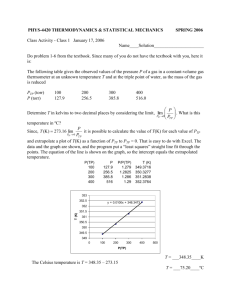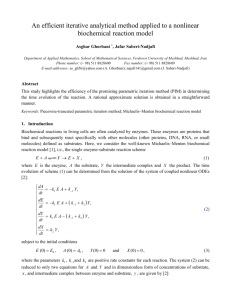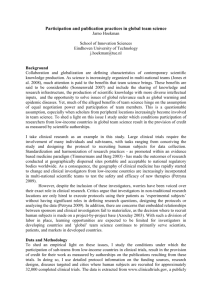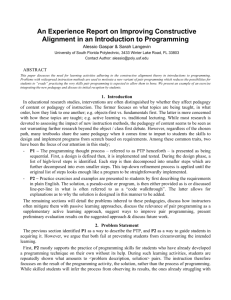An Approximate Analytical Algorithm for Solving The Multispecies Lotka-Volterra Equations
advertisement
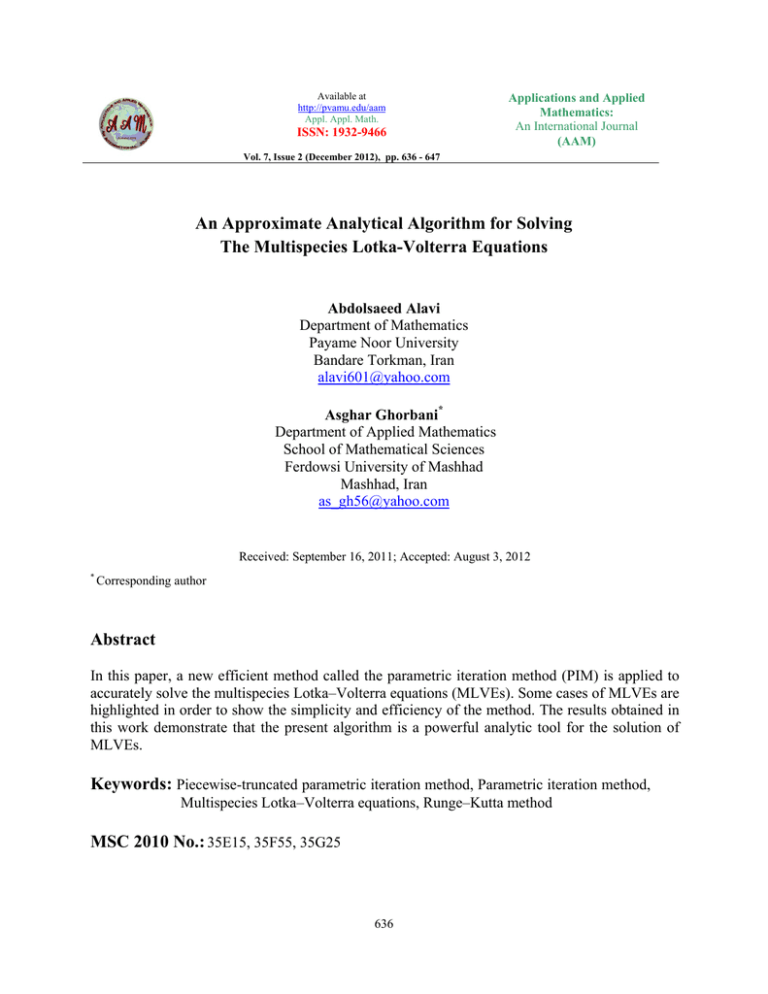
Available at
http://pvamu.edu/aam
Appl. Appl. Math.
ISSN: 1932-9466
Applications and Applied
Mathematics:
An International Journal
(AAM)
Vol. 7, Issue 2 (December 2012), pp. 636 - 647
An Approximate Analytical Algorithm for Solving
The Multispecies Lotka-Volterra Equations
Abdolsaeed Alavi
Department of Mathematics
Payame Noor University
Bandare Torkman, Iran
alavi601@yahoo.com
Asghar Ghorbani*
Department of Applied Mathematics
School of Mathematical Sciences
Ferdowsi University of Mashhad
Mashhad, Iran
as_gh56@yahoo.com
Received: September 16, 2011; Accepted: August 3, 2012
*
Corresponding author
Abstract
In this paper, a new efficient method called the parametric iteration method (PIM) is applied to
accurately solve the multispecies Lotka–Volterra equations (MLVEs). Some cases of MLVEs are
highlighted in order to show the simplicity and efficiency of the method. The results obtained in
this work demonstrate that the present algorithm is a powerful analytic tool for the solution of
MLVEs.
Keywords: Piecewise-truncated parametric iteration method, Parametric iteration method,
Multispecies Lotka–Volterra equations, Runge–Kutta method
MSC 2010 No.: 35E15, 35F55, 35G25
636
AAM: Intern. J., Vol. 7, Issue 2 (December 2012)
637
1. Introduction
In this paper, we study the analytical approximate solution of the multispecies Lotka–Volterra
equations of the type
dN i
N i bi
dt
m
j 1
aij N j ,
i 1,2,..., m
(1)
with the initial conditions
N i (0) ci ,
i 1,2,..., m,
(2)
by a new analytical method based on the parametric iteration method (PIM) proposed in [SaberiNadjafi and Ghorbani (2010)]. Here, aij , bi and ci are real constants. These equations model the
dynamic behaviour of an arbitrary number of competitors [Hofbauer and Sigmund (1988)].
Though originally formulated to describe the time history of a biological system, these equations
find their application in a number of engineering fields such as simultaneous chemical and
nonlinear control. In fact, the one-predator one-prey Lotka–Volterra model is one of the most
popular ones to demonstrate a simple nonlinear control system. The accurate solutions of the
LVEs may become a difficult task either if the equations are stiff (even with a small number of
species), or when the number of species is large [Olek (1994)]. These kinds of equations have
been solved using the approximate analytical methods such as the variational iteration method
(VIM) [Batiha et al. (2007)] and homotopy perturbation method (HPM) [Chowdhury et al.
(2007)]. However, the convergence region and rate of the corresponding results is small. In order
to overcome these shortcomings, a new analytic algorithm is proposed to simulate (1).
In our previous paper [Saberi-Nadjafi and Ghorbani (2010)], we proposed a new approximate
analytical algorithm based on the PIM called the piecewise-truncated PIM (PTP) for solving the
Abel differential equations. The new algorithm analytically approximates the solution of an
initial value problem of ODEs in a sequence of subintervals, which is continuous everywhere.
The local convergence and the stability of the algorithm were discussed in details [SaberiNadjafi and Ghorbani (2010)]. One of the main advantages of the PTP`algorithm is its ability in
providing us a continuous representation of the approximate solution, which allows better
information of the solution over the time interval. In this paper, an application of this algorithm
to solve MLVEs is introduced. Some cases of the MLVEs are examined to illustrate the
efficiency and accuracy of this method, and in all cases, the present technique performed
excellently.
638
A. Alavi and A. Ghorbani
2. The Basic Idea of the New Method
In this section, we describe the PIM and PTP algorithms for solving the nonlinear system (1).
The method gives rapidly convergent successive approximations of the exact solution if such a
solution exists, otherwise approximations may be used for numerical purposes. Also, it has been
shown in [Ghorbani (2008) and Saberi-Nadjafi and Ghorbani (2010)] that the PIM logically
contains the approximate analytical method of the VIM, which is widely used in approximate
calculations.
The idea of the PIM is very simple and straightforward. To explain the basic idea of the PIM, we
first consider (1) as follows:
L [ N i (t )] N [ N i (t )] = f i (t ),
i 1,2,..., m,
(3)
where L , with the property L g 0 when g 0 , denotes the so-called auxiliary linear operator
with respect to N i , is a nonlinear operator with respect to N i and f i (t ) is the source term.
Then, we construct a family of iterative processes for Equation (3) as [Saberi-Nadjafi and
Ghorbani (2010)]:
L [ N i , n 1 (t ) N i , n (t )] = h H i (t ) A [ N i , n (t )],
i 1,2,..., m,
(4)
with the initial condition
N i , n 1 (t0 ) = N i (t0 ),
n,
(5)
where
A [ N i , n (t )] = L [ N i , n (t )] N [ N i , n (t )] f i (t )
m
dN i , n
N i , n bi aij N j , n ,
dt
j 1
(6)
and N i ,0 (t ) is the initial guess (which can be freely chosen with possible unknown constants, or
it can also be solved from its corresponding linear homogeneous equation L [ N i ,0 (t )] = 0 ) and the
subscript n denotes the n th iteration.
The h 0 and H i (t ) 0 denote the so-called auxiliary parameter and auxiliary function,
respectively, which can be identified easily and efficiently by the techniques proposed in [SaberiNadjafi and Ghorbani (2010)]. In this work, for simplicity, we take H i (t ) 1, i 1,..., m .
It should be emphasized that though we have the great freedom to choose the auxiliary linear
operator , the auxiliary parameter h and the initial approximation N i , 0 (t ) , which is
fundamental to the validity and flexibility of the PIM, we can also assume that all of them are
properly chosen so that solution of (4) exists, as will be shown in this paper later. Accordingly,
the successive approximations N i , n (t ) (n 1) of the PIM in the auxiliary parameter h will be
AAM: Intern. J., Vol. 7, Issue 2 (December 2012)
639
readily obtained by choosing the zeroth component. Consequently, the exact solution may be
obtained by using
N i (t ) = lim N i , n (t ),
n
i 1,..., m.
(7)
Now, in order to avoid expensive computational work for solving (4) via the PIM, it is
straightforward to use the set of base functions
{ t k | k 0 , 1 , 2 , ... } ,
(8)
to represent N i (t ) , i.e.,
N i (t )
γ
i,k
γi , k R .
t k,
(9)
k 0
In view of the solution expression (8) and according to the initial condition (5), it is
straightforward to choose
L [ N i , n (t )] = N i, n (t ),
(10)
with the property (where d i is the integral constant)
L [di t ] = 0 ,
(11)
as the auxiliary linear operator, and to choose an initial approximation of N i (t ) , which is the
solution of the corresponding linear homogeneous equation L [ N i ,0 (t )] = 0 as
N i ,0 (t ) ci .
(12)
According to (4) and (10), the solution of the equation (4) becomes
dN ( s)
N i , n 1 (t ) N i , n (t ) h i , n
N i , n ( s ) bi
ds
0
t
m
j 1
aij N j , n ( s) ds,
i 1,..., m.
(13)
Therefore, the successive approximations N i , n (t ) (n 1) of the PIM iterative relation of (13) in
the auxiliary parameter h will be readily obtained, especially by means of symbolic computation
software such as Maple, Mathematica, Matlab and others.
In general, the application of the PIM to solve the MLVEs leads to calculation of unneeded
terms. The repeated calculations may or may not lead to faster convergence. In order to
completely eliminate these repeated calculations, using the integration by parts and Taylor series
640
A. Alavi and A. Ghorbani
around 0, the following improved version of the PIM called the truncated PIM (TP) is proposed
for solving the MLVEs of (1) [Saberi-Nadjafi and Ghorbani (2010)]:
N i ,0 (t ) ci ,
t
N i ,1 (t ) N i ,0 (t ) h Gi , 0 ( s) ds,
(14)
0
N i , n 1 (t ) N i , n (t ) (1 h) [ N i , n (t ) N i , n 1 (t )] h
t
G
i,n
( s ) Gi , n 1 ( s ) ds,
n 1,
0
where i 1,2,..., m and
N i , n ( s ) bi
m
j 1
aij N j , n ( s) Gi , n ( s) Ο s n 1 .
(15)
Here, we assume that the right hand (1) in each of iterations of the PIM is an analytic function. It
is worth mentioning that the TP formula (14) can cancel all the repeated calculations and terms
that are not needed. Furthermore, it is capable of solving strongly nonlinear problems with the
complicated variable coefficients in a straightforward manner. Besides, this modified method
reduces the volume of calculations and constructs a sequence which converges to the exact
solution rapidly.
By using the TP algorithm (14), we obtain a series solution, which in practice is a truncated
series solution. Unfortunately, this series solution gives a good approximation to the exact
solution in a small region of t . An easy and reliable way of ensuring the validity of the
approximations (14) for large t (i.e., [0, T ] ) is to determine the solution in a sequence of equal
subintervals t , i.e. I k [tk , tk 1 ] where Δt tk 1 tk , k 0 , 1, 2 ,..., M 1 , with t N T .
According to [Saberi-Nadjafi and Ghorbani (2010)], therefore, we can obtain the following nk 1 order piecewise approximation N ik, nk11 (t ) on I k for Equation (14), which was called the
piecewise TP (PTP):
t
k 1
k 1
k 1
k 1
k 1
k 1
N i , n 1 (t ) N i , n (t ) (1 h) [ N i , n (t ) N i , n 1 (t )] h Gi , n ( s ) Gi , n 1 ( s ) ds,
tk
k 1
k
N i ,0 (t ) = N i , n k (tk ) = ci , k , n = 0,1,..., nk 1 1,
m
1
k
N i , n ( s ) bi
aij N kj ,n1 ( s ) Gik, n1 ( s ) Ο ( s tk ) n 1 , k 0,1,..., M 1,
j 1
(16)
AAM: Intern. J., Vol. 7, Issue 2 (December 2012)
641
where N i0,n0 (t0 ) = N i (t0 ) = ci ci ,0 . Now, we can obtain the nk 1 -order PTP approximation
N ik, nk11 (t ) on [tk , tk 1 ] . Thus, in the light of (16) for k = 0,1, , M 1 , the approximate
analytical solution of (1) on the entire interval [0, T ] can easily be obtained. It should be
emphasized that the PIM and TP algorithms provide analytical solutions in [0, T ] , while the PTP
technique provides analytical solutions in [t k , t k 1 ] , which are continuous at the end points of
each interval, i.e., N ik, n k (tk ) = ci , k = N ik, nk11 (tk ), k = 0,1,..., M 1 .
Following the present subsection, the nk 1 -order approximate analytical solution via the PTP
method for Equation (1) can be written as:
nk 1
N
k 1
i , nk 1
(t )
r 0
γik, r (tk , c1 ,..., cm )
(t tk ) r Ο [(t tk ) nk 1 1 ] ,
r!
t I k [tk , tk 1 ],
(17)
where γik, r (t k , c1 ,..., c m ) is a coefficient dependent of tk and c1 ,..., cm . The expression (17)
demonstrates that the nk 1 -order PTP method has an error per step of the order of (Δt ) nk 1 1 ,
while the total accumulated error is of order (Δt ) nk 1 .
3. Choosing h and Δt in a Geometric Form
We mentioned that the PTP algorithm, in the present paper, uses a fixed number of
approximations n and a fixed step size Δ Δt to run the iterative procedure (16). So, it is
important to ensure that the numerical result obtained using the PTP algorithm (i.e., ci , k ), which
is as a series in the auxiliary parameter h and the fixed step size Δ is convergent in a large
enough region whereby the convergence region and rate are dependent upon the h and Δ . Most
important, however, is to choose the value of h in relation to Δ to make sure that the numerical
result converges fast enough in a sufficiently large region. Since we have a family of solution
expressions in the auxiliary parameter h and the step size Δ , hence, regarding h and Δ as
independent variables, a simple and practical way of selecting h in relation to Δ is to plot the
curves of the resulting series ( ci , k ) with respect to h and Δ .
Thus, if the series is convergent, there exists a segment in its figure called the hΔ -curves that
corresponds to a region of h and Δ . For brevity, we call such a region the valid region of h
with relation to Δ , i.e., R hΔ . Accordingly, if we set h and Δ values in R hΔ , we are quite sure
that the corresponding solution series converges. In order to ensure that the numerical results of
the PTP algorithm converge in the whole spatial and temporal regions, in most cases, we can find
a proper value of h in relation to Δ . Therefore, the hΔ -curves provide us with a convenient
way to show the influence of h and Δ on the convergence of the PTP algorithm.
In general, by means of the curves of ci , k versus h and Δ , only h and only Δ , it is
straightforward to know the corresponding valid regions of hΔ , h and Δ . Choosing a value in
642
A. Alavi and A. Ghorbani
the valid region, we can ensure that the corresponding solution series is convergent. In this
manner, we can direct and modify the convergence region and rate of solution series. Thus, the
auxiliary parameter h plays an important role within the frame of the PTP algorithm.
4. Some Illustrative Cases
In this section, to give a clear overview of the content of this study, several modeling cases of the
MLVEs will be tested by the PTP algorithm, which will ultimately show the simplicity,
efficiency and accuracy of this method. Moreover, the obtained results reveal that the approach is
easy to implement and accurate when applied to the MLVEs of (1) and avoids tedious
computational work. It is noticeable that these equations have been solved by some authors using
some available approximate analytical methods [Batiha et al. (2007) and Chowdhury et al.
(2007)]. However, the corresponding approximate solutions are valid for a very small interval. In
order to completely overcome this disadvantage, here we utilize the PTP algorithm to acquire
satisfactory solutions of these equations.
Case 1. One species ( m 1 )
In the one-species case, Equation (1) reduces to one species competing for a given finite source
of food [Batiha et al. (2007) and Chowdhury et al. (2007)]:
dN1
dt
N1 (b aN1 ) ,
a 0,
b 0,
N1 (0) 0, (18)
where a and b are arbitrary constants ( a 3 and b 1 ). In order to solve Equation (18) by
using the PTP algorithm, according to (16), we can obtain the following PTP approximations in
the subintervals I k :
N1k,11 (t ) c1, k hc1, k (1 3c1, k )(t tk ),
(19)
N1k, 21 (t ) c1, k [h h(1 h)]c1, k (1 3c1, k )(t t k )
1 2
h c1, k (6c1, k 1)(1 3c1, k )(t tk ) 2 , (20)
2
where k 0 , 1, 2 ,..., M 1 , c1, 0 N1 (0) 0.1 and
c1, k 1 N1k, nk11 (tk 1 ),
k 0,1,..., M 1,
nk 1 1,2,....
(21)
To investigate the valid region of the solution obtained in (20) via the second order PTP
algorithm, here we plot the curve of c1,3 and c1, 4 with respect to h and , as shown in Figures 1
and 2. According to this curve, it is easy to discover the valid region of (20). We point out that
the valid region becomes more accurate as the number nk 1 increases. It is usually convenient to
investigate the stability region of the PTP method by means of such kinds of curves.
AAM: Intern. J., Vol. 7, Issue 2 (December 2012)
643
Figure 1. (Plotting the hΔ -curves) the valid region of h with relation to the step size Δ
(Delta) for Case 1 by using the second order PTP solution where left: the curve c1,3
and right: the curve c1, 4
Figure 2. (Plotting the Δ -curves), the valid region Δ of the second order PTP algorithm when
h 1 for solving the equation (18) of Case 1 where left: the curve c1,3 and right:
the curve c1, 4
Figure 3 shows the approximate solution obtained for Equation (18) using the second order PTP
algorithm (16) when h 1 , Δ 0.1 , M 1000 and T 100 versus the numerical RK78
solution of (18) and also the difference between the second order PTP solution and the numerical
RK78 solution. It must be emphasized that only the second order term of our algorithm was used
in evaluating the approximate solution for Figure 3. It is easy to conclude from the numerical
results in Figure 3 that our approximate analytical solution using the PTP algorithm is in
excellent agreement with the numerical values in the large interval of t .
644
A. Alavi and A. Ghorbani
Figure 3. Approximate solution (left) and absolute error (right) of the second order PTP
algorithm when h 1 and Δ 0.1 for the case of the one species where Solid
line: N (t ) and Circle symbols: N RK 78 (t )
Case 2. Two species ( m 2 )
The Lotka–Volterra equations modelling two species competing for a common ecological niche
are [Batiha et al. (2007) and Chowdhury et al. (2007)]:
dN1
N1 (b1 a11 N1 a12 N 2 ),
dt
dN 2 N (b a N a N ),
2
2
21 1
22 2
dt
(22)
where the constants are chosen as
a11 0.0014, a12 0.0012, a21 0.0009, a22 0.001, b1 0.1 and b2 0.08 .
To solve Equation (22) via the PTP algorithm (16), proceeding as before, we consider a second
order PTP approximation. The approximate solution and absolute error of the second-order PTP
solution when h 1 , Δ 0.1 , M 1000 and T 100 are given in Figure 4. From the
numerical results in Figure 4, it is easy to conclude that our approximate analytical solution using
the PTP algorithm is in good agreement with the numerical values in the large interval of t .
AAM: Intern. J., Vol. 7, Issue 2 (December 2012)
645
Figure 4. Approximate solution and absolute error of the second order PTP algorithm (lines)
when h 1 and Δ 0.1 versus the numerical RK78 solution (symbols) for the
case of the two species
Case 3. Three species ( m 3 )
The following version of the Lotka–Volterra equations modelling three species shall be used
[Batiha et al. (2007)]:
dN1
N1 (1 N1 aN 2 bN 3 ),
dt
dN
2
N 2 (1 bN1 N 2 aN 3 ),
dt
dN
3 N 3 (1 aN1 bN 2 N 3 ),
dt
(23)
where a 0.1 and b 0.1 , [Batiha et al. (2007) and Chowdhury et al. (2007)]. To solve
Equation (23) through the PTP algorithm (16), proceeding as before, we consider a second order
PTP approximation. Figure 5 reveals the approximate solution and absolute error of the second
order PTP algorithm when h 1 , Δ 0.1 , M 1000 and T 100 versus the numerical
RK78 solution. It is convenient to conclude that our approximate analytical solution using the
PTP algorithm is in superior agreement with the numerical values in the large interval of t .
646
A. Alavi and A. Ghorbani
Figure 5. Approximate solution and absolute error of the second order PTP algorithm (lines)
when h 1 and Δ 0.1 versus the numerical RK78 solution (symbols) for the
case of the three species
Remark 1.
We mention that all the results here were computed using the Maple 11. Most mentionable,
however, is the fact that the authors only used the PTP algorithm with the fixed number of
approximations and fixed step sizes in solving the cases given here. Although, the authors
believe that the best PTP algorithm can be achieved by using a variable number of
approximations and a variable step size in the series solution to obtain a specified tolerance.
Remark 2.
The convergence of the numerical classical RK4 method for solving Equation (1) depends
mainly on choosing the step size Δt . While, the present PTP algorithm is rather free of this
shortcoming, using for instance the classical RK4 method with Δt 3 and greater, to solve the
case 1 leads to the divergent results. As, the convergent results of utilizing the second order PTP
algorithm with the fixed step sizes Δt 5 , 10 have been given in Figure 6 below.
Figure 6.The absolute errors of the second order PTP algorithm when (left) h 0.325 and
(right) h 0.15 for two large values of the fixed step size Δ for Case 1
AAM: Intern. J., Vol. 7, Issue 2 (December 2012)
647
In closing our analysis, we point out that several modeling cases of the MLVEs were tested
using the PTP algorithm proposed in this paper, and the obtained results have shown excellent
performance. As a result, it is easy to conclude that the PTP algorithm is a useful analytical tool
for solving the MLVEs.
5. Concluding Remarks
It is shown that the solution obtained by the classical RK4 was not valid for large step size. In
this paper, we proposed a technique which treated the PIM as an algorithm in a sequence of
intervals for getting highly accurate approximate analytical solutions of the multispecies Lotka–
Volterra equations. Unlike the purely numerical methods like the classical RK4, the solutions
here are readily given in series form. Moreover, we gave a geometric scheme for determining the
so-called valid region of the auxiliary parameter and the fixed step size. The obtained numerical
results demonstrate that the PTP algorithm is easy to implement, accurate when applied to the
MLVEs and avoids tedious computational work. This confirms our belief that the developed
approach is a promising analytic tool to solve the MLVEs and more promising because it can
further be applied to a wider class of nonlinear population ordinary models with highly accuracy.
Acknowledgement
The first author acknowledges the financial supports from Payame Noor University, Bandare
Torkman, Iran under the grant 1383-23-4-11-383.
REFERENCES
Batiha, B., Noorani, M.S.M., and Hashim, I. (2007). Variational iteration method for solving
multispecies Lotka–Volterra equations, Computers and Mathematics with Applications, 54,
pp. 903-909.
Chowdhury, M.S.H., Hashim, I., O. and Abdulaziz O. (2007). Application of homotopy
perturbation method to nonlinear population dynamics models, Physics Letters A, 368, pp.
251-258.
Ghorbani, A. (2008). Toward a new analytical method for solving nonlinear fractional
differential equations, Computer Methods in Applied Mechanics and Engineering, 197, pp.
4173-4179.
Hofbauer, J. and Sigmund, K. (1988). The theory of evolution and dynamical systems,
Cambridge University Press.
Olek, S. (1994). An accurate solution to the multispecies Lotka-Volterra equations, SIAM
Review, 36, pp. 480-488.
Saberi-Nadjafi, J. and Ghorbani, A. (2010). Piecewise-truncated parametric iteration method: a
promising analytical method for solving Abel differential equations, Zeitschrift für
Naturforschung A, 65a, pp. 529-539.
